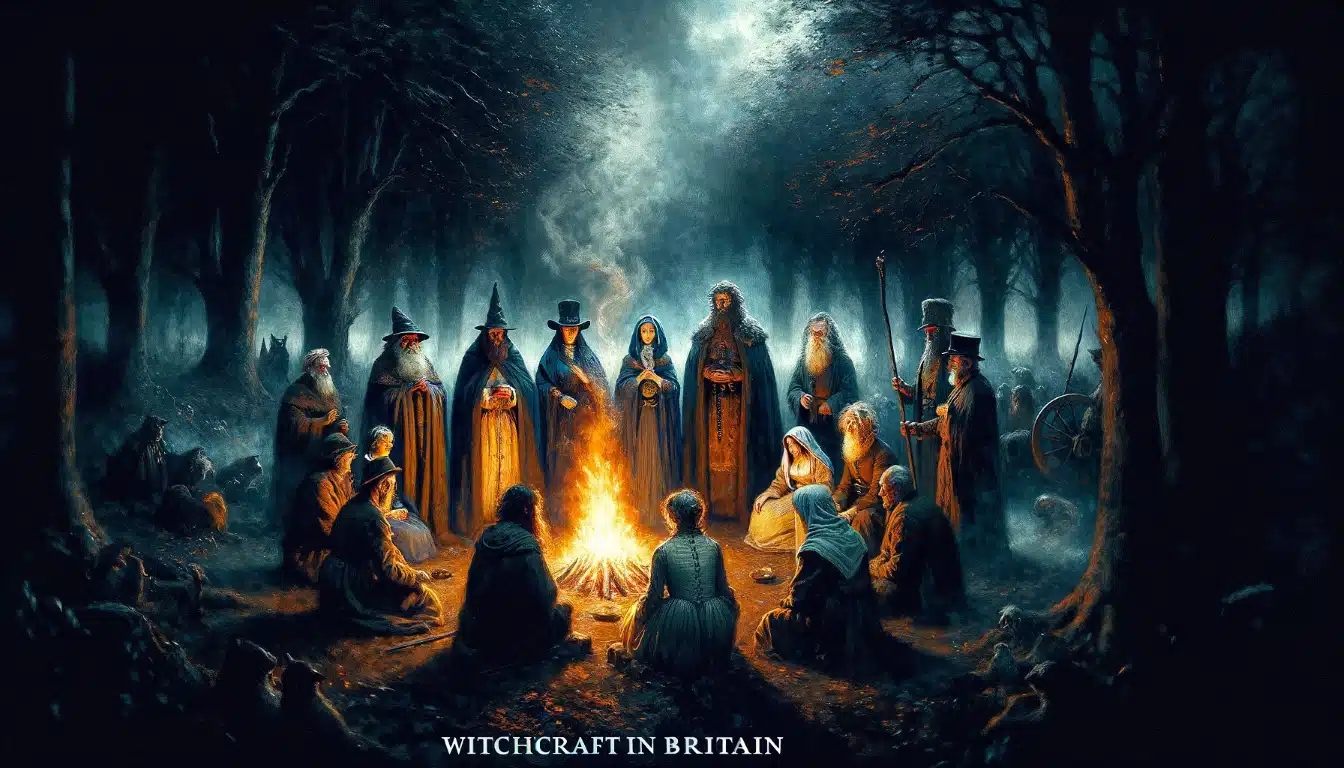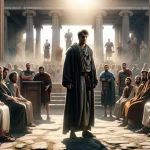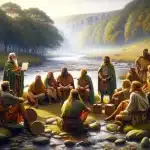Last Updated on 21/01/2024 by Alex Hamlyn
Table of Contents
Introduction to Witchcraft in Britain
if you have any interest in the history of witchcraft in Britain, you probably already know about the hysteria of the 17th century witch hunts in Britain. This was a time when superstition and fear ruled a country already deeply divided along religious and political lines.
The English civil war of the mid 1600s both grew out of, and seeded, a cultural paranoia rooted in the idea that while the people around you may look the same, and claim the same beliefs, they might secretly be the enemy.
The Reformation, begun in mainland Europe, was also partly the catalyst for these fears. Traditional and established religious thought was being threatened by new scholarly interpretations – but of course most of the people could not read these words for themselves, so they were forced to rely on the words of others. These changes also threatened the established social order, and they did not go unchallenged. False accusations, rumours, and lies have always been effective weapons, and the poor and vulnerable have always been scapegoats of the powerful.
This was a time of big changes and uncertainty, and people, through ignorance or tradition, were very suspicious of anything related to magic or the supernatural. The worst period of fear and hunts for witches in Britain happened in the late 16th century and throughout the 17th century. This was when the most witch trials and hunts happened. People were very worried about witchcraft and tried hard to stop it.
But this fear of witches didn’t just start in the 17th century. It had been around for a very long time, going back even before the Romans were in Britain. People have always been fascinated and scared by things they can’t explain, and this includes beliefs in witches and magic.
Celtic Britain and Witchcraft
In pre-Roman Britain, the Celtic tribes held deep-rooted beliefs in spirituality, heavily intertwined with nature and the supernatural. The Druids, priests and leaders in Celtic society, were integral to these beliefs. They were thought to possess extensive knowledge of nature, the spiritual world, and practices that modern perspectives might liken to magic or witchcraft. Their roles included divination, healing, and conducting rituals, acting as bridges between the gods and the people. The Celts’ animistic worldview, seeing spirits in natural elements and landscapes, likely influenced practices akin to magic. This included rituals for blessings and protection, particularly during significant seasonal festivals like Beltane and Samhain, which marked important agricultural transitions and were times of heightened spiritual activity.
As Christianity spread, it gradually absorbed, suppressed, or reinterpreted many pagan Celtic practices. Druidic traditions and the animistic beliefs of the Celts were either demonized or woven into the fabric of Christian rituals and folklore, leaving a legacy that influenced later perceptions of witchcraft and magic. In recent times, there’s been a resurgence in interest in Celtic spirituality, leading to a modern reimagining of these ancient beliefs and practices within neo-pagan and modern Druidic movements. This revival reflects a continuous fascination with the mystical and spiritual aspects of Celtic culture, highlighting its enduring impact on Britain’s historical narrative of witchcraft and magic.
Roman Britain & Witchcraft
Under Roman rule, Britain experienced an amalgamation of indigenous Celtic beliefs with Roman practices concerning magic and the supernatural. The Romans, with their pantheon of deities and acceptance of various cultic practices, introduced a more organized system of magical beliefs, which often coexisted with local traditions. This synthesis laid the groundwork for two centuries of cultural fusion of ancient magical belief and an increasing modern and educated society.
Anglo-Saxon Period
With the retreat of the Romans and the advent of the Anglo-Saxons, Britain saw the introduction of Germanic pagan beliefs, wherein magic was often linked to runes and natural forces. This period marked a shift from the Romanized magic system to a more fragmented, tribal-based belief system in supernatural practices, with a focus on charms, spells, and divination. The Christian church had begun to spread through this period, often adapting and absorbing established practices, iconography, names or ancient sites into the relatively new Christian faith.
Viking Influence
The Viking incursions brought another layer to Britain’s supernatural tapestry. Norse mythology, rich in tales of seers and runes, complemented and competed with existing beliefs. The Norse emphasis on fate and the power of seers possibly influenced local perceptions of magic and prophecy. These Norse beliefs added a new flavour to the melting pot that was British understanding of witchcraft at that time.
Norman Conquest
The Norman Conquest introduced a feudal system that somewhat centralized the cultural and religious practices. However, in terms of witchcraft and magic, the Normans did not significantly alter the existing beliefs but rather merged them with their own, which were heavily influenced by Christian doctrine. Again, the spread of the Church, this time through French Catholics, incorporated local beliefs and customs.
Plantagenet Era
During the Plantagenet rule, the Church’s stance hardened against practices deemed heretical, including witchcraft. This era saw the early codification of laws against witchcraft, setting a precedent for later, more severe legislations. The period also witnessed an increasingly systematic approach to dealing with supposed witchcraft. Shortly after, Elizabeth I issued new laws treating the crime of witchcraft with more leniency than King Henry, but this would not survive the turmoil of the 17th century yet to come.
Civil War and Restoration Period
In the 1600s, Britain experienced a period of intense witchcraft hysteria, a time when fear and suspicion of witchcraft permeated society. This era, particularly marked by the reign of King James I, saw significant legal changes that intensified the witch hunts. The Witchcraft Act of 1604, enacted under James I, was pivotal. It broadened the scope of what could be considered witchcraft, making any pact with the Devil a capital offense punishable by death. This legislation was a response to growing societal fears and the king’s own obsession with the occult and witchcraft, as evidenced in his book “Daemonologie.”
The 17th century’s witch hunts were characterized by a series of notorious trials, the most famous being the Pendle Witch Trials in 1612 and the North Berwick Witch Trials in Scotland. These trials often involved sensational and dubious evidence, usually based on confessions extracted under torture or the testimony of neighbours. Accusations of witchcraft could arise from a variety of sources, including personal vendettas, economic disputes, or unexplained misfortunes. This period saw the execution of many, predominantly women, who were accused of witchcraft.
The frenzy was fuelled not only by the new laws but also by a general atmosphere of religious and political uncertainty, as well as local folklore and superstitions that had long associated misfortune with malevolent witchcraft. The witch hunts of the 1600s stand as a dark chapter in British history, where fear and hysteria led to tragic consequences for many.
The Victorians & Witchcraft in Britain
In Victorian Britain, the era was marked by a unique contrast between rapid scientific progress and a deep fascination with the supernatural. The period saw the rise of Spiritualism, where séances and communication with the dead through mediums became popular.
Concurrently, there was a revival of interest in the occult, exemplified by groups like the Hermetic Order of the Golden Dawn, which delved into esoteric practices and ancient magical traditions. While witchcraft as a prosecutable offense had faded, it remained a potent part of folklore and literature, often romanticized as a symbol of resistance to industrialization.
Despite this intrigue with the mystical, the era was also characterized by a strong undercurrent of scientific rationalism and scepticism, leading to the establishment of societies like the Society for Psychical Research, which aimed to study paranormal phenomena from a scientific standpoint. Victorian culture encapsulated a period of dual attitudes towards the supernatural – a blend of scepticism and enchantment.
Modern Britain
In modern Britain, the perception of witchcraft and magic has undergone a significant transformation, moving away from fear and persecution to a more nuanced understanding and acceptance.
The rise of neopagan movements, notably Wicca, has played a key role in this shift. Founded in the mid-20th century, Wicca is a nature-based, pagan religion that includes the practice of witchcraft as part of its spiritual system. It has grown in popularity and visibility, contributing to a broader, more positive public perception of witchcraft as a legitimate spiritual path rather than a malevolent practice.
Additionally, modern British culture has embraced the magical and the mystical in various forms of popular media, from literature and film to festivals and tourism. The Harry Potter series, for instance, has had a considerable impact, sparking renewed interest in magic and the fantastical in a playful and positive light.
Despite this cultural shift, there remains a diversity of views on witchcraft and magic. Some people view these practices purely as part of historical heritage and folklore, while others see them as genuine spiritual or occult practices. The legal system and societal attitudes have evolved to a point where practicing witchcraft or identifying as a witch is no longer stigmatized or persecuted, reflecting a broader trend of religious tolerance and pluralism.
Modern British life and culture exhibit a multifaceted relationship with witchcraft and magic, characterized by acceptance, spiritual exploration, and a fascination with the mystical as a form of cultural expression. This is in stark contrast to the historical views touched on above. Social norms and cultural practices may have changed throughout the centuries, but the belief in and practice of the supernatural has been with us for thousands of years, and may never go away.
Read more in this series
Witchcraft in Britain
An Introduction
Witches in Roman Britain
(1st-5th century)
Viking Britain and Witchcraft
(8th-11th century)
Medieval Britain and Witchcraft
(5th century onward)
Plantagenet and High Medieval Britain (12th-15th century)
17th Century: The Peak of Witch Hunts in Britain
Modern Britain And Witchcraft – As Strange As Ever
Witchcraft and the Celts
(Pre – AD43)
Witches in Saxon Britain
(5th-11th century)
Norman Britain and Witchcraft
(11th-12th century)
Early Modern Period and Restoration (15th-18th century)
Victorian Britain and Witchcraft
(19th-20th century)
Famous Witches in British History
(Plus one Witch Hunter)


